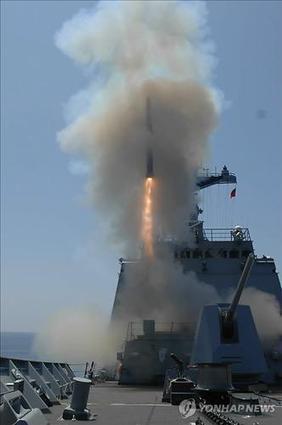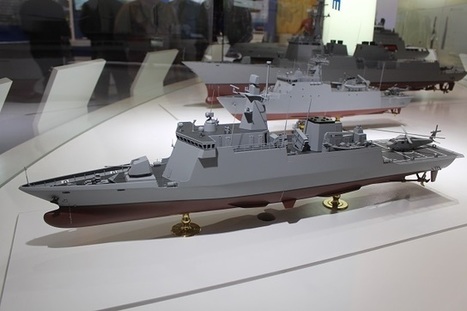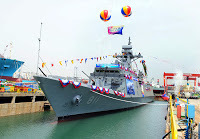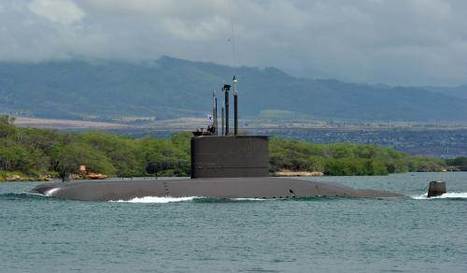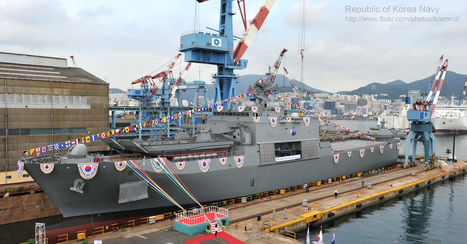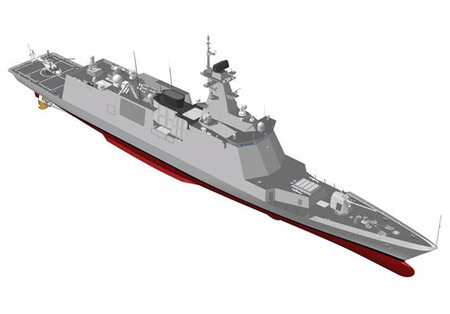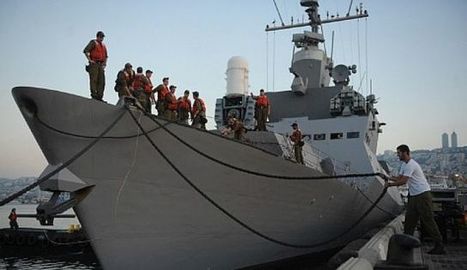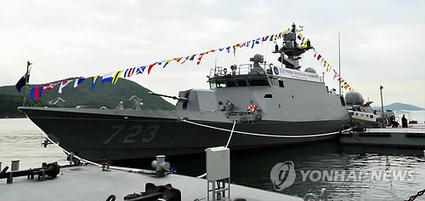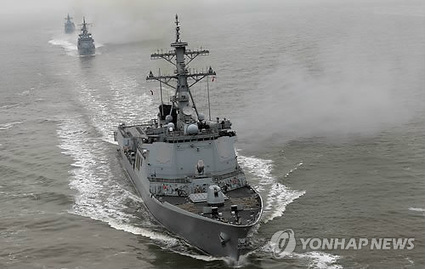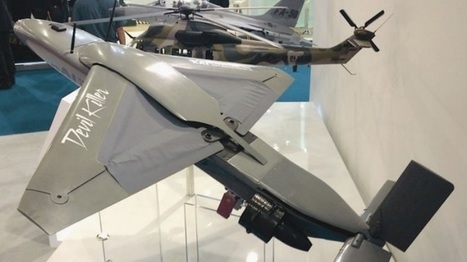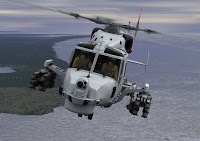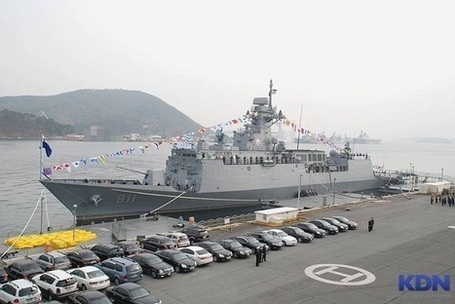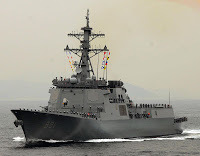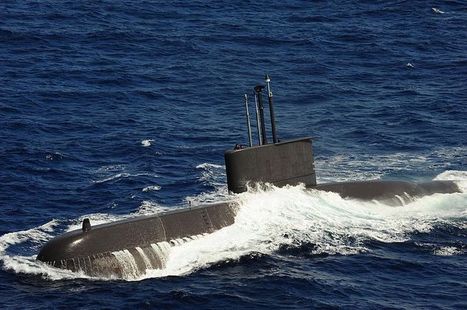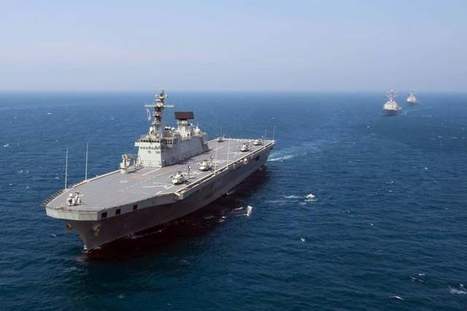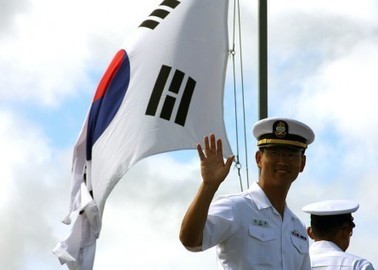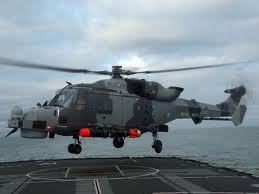 Your new post is loading...

|
Scooped by
Patrick H.
May 26, 2014 3:47 PM
|
SEOUL, May 26 (Yonhap) -- South Korea has successfully improved the quality of a homegrown torpedo, paving the way for its long-delayed mass production, the state arms procurement agency said Monday. In a test-firing on Friday, the torpedo, named "Hongsangeo," or "Red Shark," hit its intended underwater target, marking its third straight successful quality test, according to the Defense Acquisition Program Administration (DAPA). "After two years of efforts, the torpedo has now met the requirement of hitting the target successively for three rounds. The results show that its quality has been improved enough to resume its production," a DAPA official said. About 50 rounds of the anti-submarine torpedo had already been deployed since 2010, but its production was suspended after the torpedo had failed to work properly, prompting the Navy to file complaints over its quality in July 2012. The military has since conducted two rounds of additional tests, but the torpedo had failed to meet a required accuracy rate until last year, raising questions about its design. "After conducting a comprehensive technology analysis for about six months till April, we've finally learned what caused the failure, and then changed some parts to boost its resistance from external shocks," the official said. "Following the successful third round of the test-firing this time, production is expected to resume next month," he added. The state-funded Agency for Defense Development created the Hongsangeo over a nine-year period starting in 2000 with a budget of 100 billion won (US$97.6 million). Some of the Navy's destroyers were loaded with the 5.7-meter-long torpedoes in early 2012. The two-stage torpedo is launched vertically from a destroyer and flies about 20 kilometers before dropping into the sea to track and destroy a target. A precision-guided weapon like Red Shark should demonstrate more than a 75 percent success rate to be suited for combat assignment. "Taking this quality improvement as an opportunity, we will strive to provide the military with highly reliable precision-guided weapons," DAPA chief Lee Yong-geol said. The Defense Acquisition Program Agrency (DAPA) said on May 26, 2014, that the latest, third round of test-firing of the homegrown anti-submarine guided missile Hongsangeo, or Red Shark, showed improvement in its quality, paving the way for the resumption of its production next month. (Photo courtesy of the DAPA)

|
Scooped by
Patrick H.
April 15, 2014 2:29 AM
|
At DSA 2014, the 14th Defence Services Asia Exhibition and Conference currently held in Kuala Lumpur (Malaysia), Korean shipbuilder DSME introduces for the first time its Missile Surface Corvette (MSC). Navy Recognition learned during DSA 2014 that DSME teamed with a local partner to answer an RFI from the Royal Malaysian Navy for a small displacement corvette. The MSC model shown at DSA 2014 is fitted with a 76mm Oto Melara main gun, 4x Kongsberg NSM anti-ship missiles, 2x MSI 30mm guns located aft, and several South Korean made sensors, most of them from Samsung Thales.
DSME representatives at the trade show stressed however that configuration is just a suggestion and that they are ready to adapt according to customer requirements. DSME's MSC has a length of about 85.5 meters, a breadth of 12.9 meters, a draft of 3.8 meters for a displacement of about 1,800 tons.
The MSC crew consists of 60 sailors. Its top speed is 26 knots and endurance in excess of 20 days. DSME is also showing at DSA the DW3000 Frigate selected by the Royal Thai Navy. Thailand recently ordered two units of this class of ship from DSME to be delivered in 2018 and 2020. The displacement is about 3,700 tons.

|
Scooped by
Patrick H.
March 20, 2014 1:31 PM
|
ARLINGTON, VA, MARCH 19, 2014 – DRS Technologies Inc., a Finmeccanica Company, announced today a contract award to design and produce a Hybrid Electric Drive (HED) propulsion system for the Republic of Korea Navy’s future Incheon-class multipurpose frigate known as FFX Batch II (FFX-II).
The contract, valued at more than $9 million USD, was awarded to DRS’s Maritime and Combat Support Systems group by Korea’s Hyosung Corporation and will include the design, testing, and production of hybrid electric drive (HED) permanent magnet motors and associated motor drives for the first ship-set to be delivered in 2015.
The Incheon-class frigates are coastal defense frigates of the Republic of Korea (ROK) Navy. The frigates are expected to replace the aging fleet of Pohang-class corvettes and Ulsan-class frigates, and to take over multi-role operations such as coast patrol, anti-submarine warfare and transport support. The first FFX-II ship is being built by Daewoo Shipbuilding & Marine Engineering and will include a DRS HED system that will allow for more efficient and quiet operation of the propulsion plant. Up to eight FFX-II ships are planned over the next several years.
DRS’s HED permanent magnet motors, designed and built by DRS Power Technology, Inc. in Fitchburg, MA, have significant advantages in size, weight and power over conventional electric motors and produce more torque from the same amount of supplied current. Their smaller footprint allows more flexibility in engine room design and increased cargo space, and their simpler construction results in proven reliability and durability. The complementary naval marine advanced HED motor drives are designed and built by DRS Power and Control Technologies in Milwaukee, WI. With high efficiency performance at full and part load, these systems can provide significant fuel and maintenance costs savings, along with operational flexibility, when incorporated into a ship propulsion system.

|
Scooped by
Patrick H.
February 18, 2014 3:07 AM
|
State-owned shipbuilder PT PAL Indonesia will get up to US$250 million in state capital injection (PMN) under a multi-year project for the development of submarines to support the nation’s defense system.
Of that amount, $180 million will be channeled this year, according to Deputy Finance Minister Bambang Brodjonegoro at a hearing with lawmakers at the House of Representatives on Monday.
Bambang added that out of the $250 million given to PAL, $150 would be used for the construction of the shipyard, $30 million for “consultation” and that $70 million would be spent on personnel, such as experts and technicians.
The PMN will be included in the revised state budget (APBN-P) for 2014 and the State-Owned Enterprises (BUMN) Ministry will oversee the matter.
To develop the submarines, PAL will work with South Korean shipbuilder Daewoo Shipbuilding and Marine Engineering (DSME).
Based on the contract between DSME and the Indonesian Defense Ministry in 2011, PAL’s shipyard must be completed and ready by November 2014.
The contract also states that the first two submarines will be built completely at a DSME plant in South Korea and that the third submarine will be built completely by PAL in Indonesia through the transfer of technology and knowledge.
Although the project is already running behind schedule, Navy chief of staff Adm. Marsetio claimed that the submarines built at the DSME plant were expected to be completed by 2017, while the one to be built by PAL was predicted to be completed by 2019 or 2020. “The facilities needed for construction must be ready by November. Therefore, due to the time limit, the budget must be submitted [to the House] by April or May at the latest,” said House Commission on defense, foreign affairs and intelligence lawmaker Tubagus Hasanuddin at the hearing... ...Aside from building capable shipyards, Indonesia must also send 206 technicians and experts to DSME as part of the technology transfer set out in the contract. However, as of February, PAL has only sent 13 people.

|
Scooped by
Patrick H.
January 10, 2014 1:11 PM
|
South Korea's Defense Administration Program Agency (DAPA) announced on 26 December it had awarded Hyundai Heavy Industries a KRW136.4 billion (USD129 million) contract to build a second LST-2 class landing ship for the Republic of Korea Navy (ROKN). The new vessel is expected to be delivered in 2016. The ROKN currently has five 4,278-tonne Alligator-class LSTs and two ageing 4,080-tonne 512/1152-class LSTs in service. The first LST-2 is currently under construction by Hanjin Heavy Industries and Construction.

|
Scooped by
Patrick H.
December 31, 2013 7:56 AM
|
The Korean Navy has placed an order with Daewoo Shipbuilding & Marine Engineering (DSME) for construction of an Incheon Class frigate worth USD 305.8 million. As stipulated by the contract, DSME is obliged to construct and deliver the frigate to the South Korean Navy by 2017. With introduction of the Incheon class frigates South Korean Navy plans to replace the aging fleet of Pohang class corvettes and Ulsan class frigates. The class is said to be built in several batches. Batch I will see construction of six vessels while eight will be built as Batch II by Daewoo Shipbuilding & Marine Engineering. A third batch is also planned, but it is still at an early stage of development. The frigate is capable of performing various roles including coast patrol, anti-submarine warfare and transport support. Boasting a displacement of 2,300t, the warship covers an overall length of 114m, width of 14m and a depth of 25m. The complement of the frigate is up to 170 crew members. The latest contract leaves Daewoo Shipbuilding with cumulative orders of 57 ships and offshore plants worth $13.6 billion for this year. Daewoo Shipbuilding has won orders for warships worth $1 billion so far this year, reaching the mark for the fourth consecutive year since 2010.

|
Scooped by
Patrick H.
December 8, 2013 3:57 AM
|
The Defense Ministry is expected to ask the Finance Ministry for a budget increase of some 3 billion shekels ($853 million) to purchase four missile boats for protection of Israel’s offshore natural gas fields. The planned acquisition was first reported in Haaretz over the weekend. The extra money may be defined as a special expenditure rather than a part of the regular defense budget, to avoid swelling the military procurement budget for future years. But as far as is known, neither the full cabinet nor the political-security cabinet has discussed how to finance the protection of the offshore fields. The German newspaper Bild reported on Saturday that following months of negotiations, Berlin has agreed to sell Israel two advanced gunboats at a cost of 1 billion euros. It said Israel’s national security adviser, Yossi Cohen, was in Berlin last week to discuss the deal. But the negotiations with Germany are still in the early stages, and Israel is also holding talks with gunboat manufacturers in South Korea and the United States. A few months ago, Defense Minister Moshe Ya’alon and Israel Defense Forces Chief of Staff Benny Gantz approved plans to purchase four large gunboats to help the navy protect the gas fields and recruit another few hundred sailors to operate these vessels. The cabinet tasked the Israel Defense Forces with protecting these fields even though they are owned by private companies. The fields are located within Israel’s exclusive economic zone, defined as the area within 200 nautical miles (370 kilometers) of the country’s coastline. The navy has already started protecting the gas fields via patrols by its Sa’ar-5 missile boats and other vessels. These patrols have become more frequent since the gas actually started flowing. But the navy said four extra gunboats would provide a more comprehensive defense of Israel’s exclusive economic zone, and the diplomatic-security cabinet approved the navy’s plan. The drilling sites themselves are protected by private security forces comprised of veterans of elite army units, as well as by aerial patrols, including drone flights, and other means. The navy currently has 13 missile boats, including three of the advanced Sa’ar-5 class. Earlier this year, the IDF announced that due to budget constraints, it would take two of the older missile boats out of service. The Sa’ar-5 boats were purchased in the United States. Nevertheless, Israel decided to negotiate with Germany – the supplier of its Dolphin submarines – over the acquisition of the new missile boats. But since Germany is still in a political transition following its September election, the talks will go into high gear only after Chancellor Angela Merkel’s new government is sworn in. Israel has so far acquired six Dolphin submarines from Germany, with the first deal signed in the late 1980s. The first three submarines, delivered in the ‘90s, were given as a gift as part of the special relationship between the two countries. The other three cost Israel only 1.4 billion euros, since the German government covered one-third of the cost. The navy has bought most of its gunboats from the United States; Israel used its annual U.S. military aid for the purchases. Once a deal is signed, the navy expects the boats to be delivered gradually over the next three to four years. Until then, it will continue patrolling the gas fields with its existing gunboats.

|
Scooped by
Patrick H.
November 25, 2013 10:52 AM
|
CHANGWON, South Korea, Nov. 25 (Yonhap) -- A moored Navy guided missile patrol boat under construction sank at a shipyard due to strong winds, the shipbuilder said Monday. Sources said the 430-ton Gumdoksuri Class patrol killer guided missile (PKG) boat started sinking at around 3 a.m. as it was pounded by strong winds and waves. The boat, armed with 76 millimeter guns, was one of 24 being built to replace smaller Chamsuri Class patrol boats serving in the Navy. The name of the shipyard on the southern coast was not revealed, although the builder confirmed that roughly 60 percent of the work, including the engines, were on board at the time of the accident. "It started sinking by the stern, resulting in roughly four-fifths of the boat being submerged," a company representative said. He said the bow of the boat was tied to a large vessel. "There is a chance that water pouring into the boat through opened hatches may have caused her to sink, although the Navy and police will provide more accurate details," the representative speculated. He, however, said there was no one on board at the time of the sinking. The shipyard, meanwhile, employed a 3,000-ton capacity crane to try to lift the boat, but this failed because of the water in the hold. It said once waves die down divers will go into the submerged ship to pump out water that will allow it to be re-floated more easily.

|
Scooped by
Patrick H.
November 13, 2013 10:38 AM
|
Le groupe Daewoo Shipbuilding&Marine Engineering (DSME) participera à la création d'un centre de construction navale en Extrême-Orient russe conformément à un accord signé mercredi dans le cadre d'une visite du président russe Vladimir Poutine en Corée du Sud. "Le groupe russe Rosneft, la Gazprombank (Russie), la compagnie de navigation maritime russe Sovkomflot et Daewoo Shipbuilding&Marine Engineering Co., Ltd ont signé un mémorandum de compréhension sur les principes de base de leur coopération dans la création d'un centre de construction navale dans le sud du territoire du Primorié", rapporte Rosneft dans un communiqué. Les sociétés se sont mises d'accord pour achever les travaux de construction et lancer les nouveaux chantiers navals baptisés "Zvezda" dès 2016, créer un centre d'ingénierie russo-sud-coréen pour la construction de navires et de plateformes pétrolières et ont formulé les modalités d'échange de technologies et de placement des commandes, selon le communiqué. La cérémonie de signature du mémorandum s'est déroulée en présence des présidents russe et sud-coréenne, Vladimir Poutine et Park Geun-hye. DSME a déjà essayé de participer à la construction des chantiers navals russes en Extrême-Orient. En 2009, la Russie a commencé la construction des chantiers navals Zvezda qui étaient initialement considérés comme une coentreprise russo-sud-coréenne. Mais DSME a cessé de financer le projet en 2012. La Russie a plus tard modifié le projet. "Zvezda" est devenu une filiale à 100% du Centre de construction et de réparation navales de l'Extrême-Orient, qui fait partie du Groupe unifié de construction navale russe (OSK). Fin août 2013, le président russe Vladimir Poutine a confié la construction des chantiers navals à un consortium d'investisseurs privés dirigé par Rosneft et Gazprombank. Sovkomflot a aussi souhaité rejoindre le projet.

|
Scooped by
Patrick H.
November 4, 2013 2:21 AM
|
SEOUL, 04 nov. (Yonhap) -- La marine nationale a reçu son 12e destroyer de construction locale doté de missiles guidés, qui sera déployé pour protéger les zones côtières du pays, a fait savoir ce lundi l'Administration du programme d'acquisition de défense (DAPA). STX Offshore & Shipbuilding Co. a livré le patrouilleur de classe PKG (Patrol Killer, Guided Missile) au commandement de la marine, situé à Jinhae, à 410 kilomètres au sud de Séoul. Le bateau de 450 tonnes peut naviguer à une vitesse de 40 nœuds et est doté de missiles antinavires d'une portée de 140 kilomètres. Il embarque également des canons d'artillerie navale de 76 mm et peut accueillir 40 membres d'équipage. Le navire se joindra aux missions de patrouille de la marine deux mois après son déploiement, a ajouté la DAPA.

|
Scooped by
Patrick H.
October 25, 2013 6:33 AM
|
BUSAN, Oct. 25 (Yonhap) -- South Korea has developed its first radar-absorbing paint to camouflage its warships, fighter jets and tanks to help them bypass detection, a local university institute said Friday, in its latest efforts to arm the nation's weapons with stealth features. Korea Maritime and Ocean University's Stealth Technology Center unveiled the "stealth paint" designed to have a low detectability during the International Naval & Defense Industry Exhibition held in the southeastern port city of Busan from Tuesday to Friday. Stealth technology has been considered one of the key features that raise survivability during wartime, with many countries developing related technologies, designs and materials. During the exhibition that drew some 1,590 companies from 55 nations and foreign delegations, military officials from such countries as the United States and China, which keep much of their stealth technology highly confidential, have paid keen attention to the radar-absorbing paint, the center's exhibition team said. The radar-absorbing material can be applied with a spray to make it lighter, durable and cheaper than the current tile- or sheet-type electromagnetic wave absorbers made of an iron mixture, Kim Yong-hwan, the director of the Stealth Technology Center, said. "This paint greatly decreases warships' visibility on radars to help raise their survivability from missile attacks," the former Navy Captain said, showing an iron sheet coated with the paint that absorbs up to 99 percent of radar waves. While the paint has recently passed certification in 11 categories by the Korea Testing & Research Institute, it is expected to first be applied in naval weapons systems as South Korea has the world's three biggest shipbuilders. Daewoo Shipbuilding & Marine Engineering is among the companies that are eyeing the material for their latest Navy destroyers under development, said Hwang Young-woo, the center's vice president. "It is easy to apply evenly to any surface as it is a spray, saving considerable time compared to other sheets or tiles," Hwang said. "Plus, it's much cheaper than the normal paint."
As the South Korean military has included the development of radar-evading and anti-stealth technology in its long-term defense strategy, Hwang said the center has been developing various types of paints to meet different requirements for the Navy and Air Force, and is consulting with local defense contractors. The paint for warships needs to withstand corrosion from sea waters, while the material for fighter aircraft must endure the high engine temperature and frictional heat.

|
Scooped by
Patrick H.
October 24, 2013 3:40 AM
|
DAEJEON, Oct. 23 (Yonhap) - An Austrian-made unmanned aerial vehicle (UAV) procured by the South Korean Navy is susceptible to GPS jamming, raising concerns that the spy drone will be vulnerable once it is deployed to gather intelligence on North Korea, a ruling party lawmaker said Wednesday. The Navy spent 25 billion won (US$23.6 million) to purchase four S-100 UAVs made by Austrian company Schiebel, the Navy said in its report submitted to the parliament. It wants to deploy them on intelligence ships that patrol seas near the western sea border, the so-called Northern Limit Line. The drones are currently undergoing testing. Although the Austrian company says the UAVs are equipped with multiple backup inertial navigation systems, Rep. Song Young-keun of the Saenuri Party claimed the UVAs don't have the capability to withstand long-lasting GPS jamming. "Although there is an alternative system, it lowers the efficiency of the weapons system and stops functions in the worst case, affecting accuracy," Song said during an audit on the Navy at its headquarters in Daejeon, 164 kilometers south of Seoul. Concerns have grown over the GPS jamming after one of the drones crashed in May 2012 during a test flight near the western port city of Incheon. The accident killed a Slovakian test pilot from Schiebel and injured two South Koreans. Experts suspect jamming of its GPS receiver may have contributed to the crash, as North Korea is believed to have masterminded massive GPS jamming that affected hundreds of commercial flights and ships in the previous month. The Navy's intelligence gathering project on the North Korean military has been crippled for several years after two UAVs crashed during operations. Among the three fixed-wing SHADOW-400 UAVs by American company AAI, one crashed during operations near a western island in 2007, and another went down in waters near the southeastern port city of Pohang in 2010. The third one is currently not operating.

|
Scooped by
Patrick H.
October 21, 2013 3:38 AM
|
BUSAN, Oct. 21 (Yonhap) -- An international naval defense industry exhibition will be held in the southeastern port city of Budan this week to showcase the latest naval weapon systems and warships, organizers said Monday. The biennial International Naval & Defense Industry Exhibition will be held at BEXCO in the southern port city of Busan from Tuesday to Friday, bringing together some 1,590 companies from 55 nations with 2,420 promotional booths for maritime products and weapon systems, the Navy said. During the four-day event, South Korea will showcase long-range anti-submarine torpedoes, heavyweight torpedoes, unmanned submarines and landmines removal robots to military officials and foreign buyers, it said. Visitors will be able to have the real-ship experience through simulators of Aegis destroyers, amphibious assault ships and submarines in the venue. On Wednesday, the Navy will carry out maritime maneuvers in the southern coast to present South Korea's latest warships equipped with anti-ship and anti-aircraft missiles as well as maritime aircraft. Navy delegations from 20 nations will visit South Korea's major defense companies, including Daewoo Shipbuilding & Marine Engineering, LIG NEX 1 and Samsung Thales, and meet with officials to discuss ways to boost cooperation, the Navy said. On the sidelines of the event, the state-funded Agency for Defense Development and the Navy will jointly hold international seminars on Wednesday and Thursday, which will present 68 research papers on the latest shipbuilding technology. The exhibition has been co-hosted by the Busan Metropolitan City and the Korea International Trade Association since 2001 to promote South Korea's shipbuilding industry led by the world's leading companies, such as Daewoo, Hyundai and Samsung.
|

|
Scooped by
Patrick H.
May 22, 2014 3:19 AM
|
Seoul formally protested joint naval drills by China and Russia in the East China Sea that intruded into Korea’s air defense identification zone (Kadiz).
According to the Korean Ministry of National Defense on Tuesday, the training area for the military exercises conducted by Beijing and Moscow partly overlapped with the Korean and Japanese ADIZs. Seoul was barely given any prior notice.
A no-fly zone declared by China for the joint maritime drill with Russia intruded 230 kilometers (142 miles) northward into the Kadiz and 172 kilometers eastward, according to a Korean military official.
Defense Ministry spokesman Kim Min-seok said that in a response, Korea stepped up surveillance and reconnaissance activities in the part of its air defense zone area in which China and Russia were conducting military exercises.
He did not specify whether any Russian or Chinese aircraft or ships actually crossed into Korea’s ADIZ.
This is the first time Beijing carried out such military drills in the region since Korea expanded its ADIZ last December.
Last November, China proclaimed a new air defense identification zone in the East China Sea that overlaps Korea’s and Japan’s at points where the countries have disputes over claims, such as Ieodo, underwater reefs that belong in waters that both Seoul and Beijing claim. The sudden and unilateral announcement raised fears of heightened geo-political tension in the region.
As submerged reefs, Ieodo cannot be considered disputed territory but Korea and China’s exclusive economic zones (EEZs) overlap at that point.
Korea responded by expanding its own ADIZ in December to incorporate waters surrounding its remote islands, including Ieodo.
China unilaterally announced a no-fly zone on its government website Friday in preparation for the China-Russia naval drill, four days before it started.
The Defense Ministry summoned a defense official from the Chinese Embassy in Seoul Tuesday and warned Beijing to inform Korea of future military drills that will overlap its Kadiz.
Russia and China’s weeklong naval cooperation drills involving submarines, warships, fighter jets and combat helicopters run until Monday. This is the third such joint naval exercise, but the first to be held in the sensitive East China Sea. The drill coincided with Russian President Vladimir Putin’s visit to China. Putin launched the military exercise with President Xi Jinping on Tuesday... Lire l'article complet : http://koreajoongangdaily.joins.com/news/article/article.aspx?aid=2989538

|
Scooped by
Patrick H.
March 23, 2014 12:17 PM
|
PYEONGTAEK, Corée du Sud, 23 mars (Yonhap) -- La marine sud-coréenne a renforcé les capacités de défense de ses navires de guerre pour mieux pouvoir répondre aux menaces posées par la Corée du Nord, après le torpillage de la corvette Cheonan il y a quatre ans. La corvette de 1.200 tonnes le Cheonan avait coulé en mer Jaune dans la nuit du 26 mars 2010, tuant 46 membres d’équipage. L’enquête sud-coréenne avait déterminé que le navire a été torpillé par la Corée du Nord. Pyongyang a nié être à l’origine de l’attaque. Ce drame a mis en évidence le danger que posent les attaques de la Corée du Nord, danger confirmé quelques mois plus tard par le pilonnage de l’artillerie nord-coréenne sur l’île Yeonpyeong, qui avait fait quatre morts, deux soldats et deux civils. L’Institut de recherche pour la sécurité des affaires nationales a identifié une éventuelle provocation nord-coréenne près de la frontière maritime occidentale comme l’un des trois plus grands risques liés à la sécurité pour la Corée du Sud cette année. Deux affrontements maritimes meurtriers ont déjà eu lieu près de cette frontière, en 1999 et en 2002. «La Corée du Nord pourrait attaquer gratuitement un navire sud-coréen au sud de la frontière maritime pour se venger des escarmouches navales passées, faisant de cette frontière un lieu sensible», a déclaré l’institut dans un récent rapport sur la situation sécuritaire. La Corée du Sud a renforcé ses capacités de défense le long de la frontière maritime occidentale en déployant plus de sous-marins, de navires et d’armes anti-torpilles dans la zone et en renforçant son artillerie dans les îles frontalières. Les navires de guerre et sous-marins ont été en outre équipés ces dernières années de missiles de croisière d’une portée de plus de 1.000km. Quinze destroyers équipés de missiles guidés et de sonars avancés ont été déployés en mer Jaune et en mer de l’Est et vingt nouveaux navires viendront remplacer les navires de patrouille existants dans les dix prochaines années. La Corée du Nord a récemment mis au point un nouveau type de navire de débarquement destiné, selon les autorités sud-coréennes, à rapidement prendre possession des îles sud-coréennes en cas de guerre. Le pays possède de plus environ 70 aéroglisseurs sur sa côte ouest et 60 navires amphibies sur sa côte est, prêts à être utilisés. Pyongyang a aussi mis au point de nouveaux navires de guerre de 200 tonnes équipés de canons de plus gros calibre qu’auparavant et ajoute chaque année à sa flotte de 70 sous-marins un ou deux sous-marins de poche. Le besoin de renforcer les capacités navales du pays est d’autant plus pressant que la Chine et le Japon revendiquent de plus en plus agressivement leur territoire en mer de Chine orientale. La Corée du Sud a mené mercredi un exercice naval de grande envergure en mer Jaune à l’approche du quatrième anniversaire du torpillage du Cheonan, auquel ont participé le destroyer King Sejong the Great de 7.700 tonnes équipé du système Aegis, des navires d’escorte, plusieurs autre navires et un hélicoptère Lynx.

|
Scooped by
Patrick H.
February 18, 2014 1:15 PM
|
Korea Aerospace Industries (KAI) is marketing a small unmanned air vehicle (UAV) which can also be used as a precision munition as a viable maritime capability deployable on board naval vessels. The 'Devil Killer' UAV could previously only be launched from ships with the aid of rocket boosters. However, the company has now introduced a canister containing a compressed air mechanism to provide the initial launch thrust required to enable the system to become airborne. This thrust capability enables the system to be deployed at sea. Once launched, switch blade wings unfold and two electric ducted fans take over the propulsion task for the rest of the flight. Speaking to IHS Jane's at the Singapore Airshow on 14 February, KAI's senior manager and chief of international marketing Jei Yai Moon said that the company is now marketing the UAV as a munition that feasibly can be deployed at sea as well as being an effective land-launched system. "The Devil Killer UAV is ready for production. Unfortunately we do not have a customer yet. We will continue to market it", said Moon. Described by the company as a "tactical suicide combat UAV", the Devil Killer is designed to loiter above potential targets. The UAV would be guided by an operator onto its designated target using a video data link and would then crash itself onto the target, detonating a 2 kg payload located between its wings. The Devil Killer is 1.5 m long and has a wingspan of 1.3 m. It weighs 25 kg when armed and has demonstrated in-flight top speeds of 400 km/h. It has a maximum range of 40 km.

|
Scooped by
Patrick H.
January 27, 2014 2:20 AM
|
SEOUL, 27 jan. (Yonhap) -- La marine nationale a reçu son 13e destroyer fabriqué en Corée du Sud doté de missiles guidés, qui sera déployé pour participer à des missions de patrouille afin de défendre des zones côtières, a déclaré ce lundi l'Administration du programme d'acquisition de défense (DAPA). Hanjin Heavy Industries & Construction a livré le patrouilleur de classe PKG (Patrol Killer, Guided Missile) au commandement de la marine, situé à Jinhae, à 410 kilomètres au sud de Séoul. Le bateau de 450 tonnes peut naviguer à une vitesse de 40 nœuds et est doté de missiles antinavires d'une portée de 140 kilomètres. Il embarque également des canons d'artillerie navale de 76 mm et 40 mm, et peut accueillir 40 membres d'équipage. Le navire se joindra à des missions de patrouille de la marine deux mois après son déploiement, a ajouté la DAPA.

|
Scooped by
Patrick H.
January 6, 2014 3:19 AM
|
More Israeli-made Spike missiles with the maximum range of 25 km will be installed in maritime helicopters ready for deployment next year.
Several Spike missiles are already installed on vehicles defending the northwesternmost islands.
But the new lot will be mounted on Wildcat maritime choppers to be purchased over the next two years, an official with the Defense Acquisition Program Administration said Friday. "We've recently struck a deal with the Israeli manufacturer of the missile."
The Spike missile is allegedly capable of hitting a window-size target 25 km away guided by infrared.
An officer said the missile can hit the North's coastal artillery as well as its high-speed boats or hovercraft if they launch surprise landings on South Korean territory.
A total of eight Wildcat helicopters will be procured, each of which can carry four Spike missiles. The missiles cost about W300 million (US$1=W1,056) each, approximately 100 times the price of a shell for the K-9 self-propelled howitzer.

|
Scooped by
Patrick H.
December 8, 2013 5:41 AM
|
MANILA, Philippines - Four companies have qualified for the next stage of the bidding for the acquisition by the Philippine Navy of two frigates worth P18 billion. Navantia Sepi (RTR Ventures) of Spain and South Korean firms STX Offshore & Shipbuilding, Daewoo Shipbuilding & Marine Engineering Co. Ltd. and Hyundai Heavy Industries, Inc. hurdled the first stage of the bidding process, which involved the inspection of company documents, The STAR learned. Fourteen firms bought bid documents but only seven submitted bids for the frigate acquisition project, one of the big-ticket items in the Armed Forces of the Philippines’ upgrade program. The ships can be used to boost the Philippines’ security presence in the West Philippine Sea and conduct humanitarian missions. The Department of National Defense’s bids and awards committee said documents submitted by three of the seven bidders had deficiencies. Garden Reach Shipbuilders & Engineers Ltd. of India, STX France SA and Thyssenkrupp Marine System can still file a motion for reconsideration to prove that they are qualified to bid for the project, the committee said. The seven firms that bought bid documents but did not submit offers were Piriou Naval Services, Damen Shipyards, Fincantieri, DCNS France, Magazon Dock Pipavav Defense Pvt. Ltd., Stone of David and Rouvia Yachts / Rouvia Defense Inc. Second stage The second stage of the bidding will involve the opening of financial proposals and technical documents. This phase will determine if the bidders’ offers are well within the approved budget of P18-billion and if their goods are in line with the specifications provided in the bid documents. The second phase of the bidding will be held this month. The government decided to conduct a two-stage competitive bidding due to the technical and detailed nature of the project. The winning bidder is required to deliver the ships within four years from the opening of a letter of credit, a document that assures the supplier that the government will honor its financial obligations. This means that that the vessels may arrive in the country after President Aquino steps down from office in 2016. Defense officials, nevertheless, said what is important is they have started to modernize the Philippine Navy, said to be one of the ill-equipped units in the region.

|
Scooped by
Patrick H.
December 1, 2013 9:03 AM
|
SEOUL, Dec. 1 (Yonhap) -- South Korea will finalize a plan later this month calling for the building of three more Aegis destroyers that can better cope with threats from North Korea and other regional security developments, a military source said Sunday. The insider, who wished to remain anonymous, said the plan is expected to be finalized at a meeting of the Joint Chiefs of Staff on Dec. 22. The meeting will be chaired by Joint Chiefs of Staff Chairman Choi Yun-hee. South Korea already has three Aegis ships belonging to its King Sejong the Great class, which are 165 meters long from stem to stern, and have a full war load displacement of over 9,000 tons. These ships, equipped with the latest phased array radar and other sensors, can deal with all kinds of air, surface and submerged threats, and permit the country to project its power far beyond South Korean waters. "The military brass has reached an agreement that Seoul needs the state-of-the-art ships," the official said. The military had originally planned to discuss and finalize the additional building plan for the warships last month, yet this had been delayed because the procurement was not deemed urgent at the time. This view changed with Beijing redrawing its air defense identification zone (ADIZ) on Nov. 23, which overlaps similar airspace drawn up by South Korea and Japan. Seoul has since called on China to reconsider its move, but Beijing has rejected the request, saying the new ADIZ does not target South Korea. Meanwhile, once the ships are in service with the Navy, South Korea will have the means to create three or four mobile squadrons to better defend its territories, such as the Dokdo Islets in the East Sea and the Ieodo Ocean Research Station. The building of the ships will cost 3 trillion won (US$2.8 billion), with the destroyers expected to enter service during the 2022-2028 period. A mobile squadron can be made up of 2 Aegis ships, two smaller Chungmugong Yi Sun-shin Class destroyers, one sea-borne replenishment ship and two next-generation submarines. This can be supplemented by 16 helicopters and fixed-winged maritime reconnaissance planes like the P-3C Orion.

|
Scooped by
Patrick H.
November 18, 2013 12:42 PM
|
Paris November 18, 2013 - Sagem (Safran) beat out an international field to win the contract from Daewoo Shipbuilding & Marine Engineering Co. Ltd (DSME) of South Korea as prime contractor for the navigation system to be installed on three 1,400 ton ocean-going submarines to be deployed by the Indonesian navy.
Ordered by Indonesia in 2012, this new class of ocean-going submarine is the first South Korean-designed submarine to be sold in international markets.
The Sagem navigation system (NAVS) offers outstanding reliability and precision, making it the best system for demanding submarine missions, whether at sea or for operations along coastlines. NAVS comprises two high-performance Sigma 40XP laser gyro inertial reference units, a computer and safety-critical navigation software, all contributing to the submarine’s stealth and safety during dives.
The decisive factors in DSME’s choice were Sagem’s proven capabilities as systems integrator, plus its expertise in data fusion and transmission to the ship’s combat system, along with extensive experience in managing major defense programs.
This latest contract underscores the quality of the relationship between Korean industry and Sagem on navigation systems, and the predominance of laser technology in submarine navigation systems. South Korea’s Defense Acquisition Program Administration (DAPA) had already chosen Sagem recently to modernize the navigation system on the country’s KSS-1 Chang Bogo submarines class, several modernized submarines are already in full operation at sea.
Through this contract, Sagem further consolidates its leadership in navigation systems for today’s submarine forces. Over 60 submarines around the world, in 14 different classes, are now fitted with Sagem navigation systems, including nuclear submarines (SNLE-NG, Barracuda, SNA Améthyste), air-independent propulsion (AIP) types and diesel-electric models (Scorpène family). More than 400 surface vessels are also equipped with Sagem inertial navigation systems.

|
Scooped by
Patrick H.
November 13, 2013 4:31 AM
|
Hyundai Heavy Industries (HHI), the world’s biggest shipbuilder, today held a launch ceremony for its fifth frigate, ROKS Jeonbuk, the company said in its press release.
The launch ceremony was attended by the Chief of Naval Operations Admiral Mr. Hwang Ki-chul, governor of Northern Jeolla Province Mr. Kim Wan-ju, Hyundai Heavy’s president & CEO Mr. Lee Jai-seong and other government and military officials in Ulsan shipyard.
The Jeonbuk frigate has greatly improved capabilities with its weapon and sensors including new 3-D radar, antiaircraft & antiship missiles, and sonar & torpedo acoustic counter measures. In addition, the vessel uses stealth technology to minimize the exposure to electromagnetic waves. More than 90% of major equipment is locally developed and sourced.
The 2,300 tonne frigate, measuring 114 m long, 14 m wide, and 25 m deep, can sail at a maximum speed of 30 knots with a crew of 120. The frigate will be delivered to the Korean Navy in December 2014.
The Ulsan, South Korea-based shipbuilder delivered its third frigate ROKS Incheon in January this year and is also currently building its fourth frigate ROKS Gyeonggi scheduled to be delivered in October 2014.
Since constructing and delivering the first Korean-built frigate ROKS Ulsan in 1980, Hyundai Heavy has grown as a leading naval shipbuilder by delivering 63 naval ships including the first and the third Korean Aegis destroyers, 3 KDX-II destroyers, 5 frigates, 3 submarines, and 29 patrol·salvage ships.

|
Scooped by
Patrick H.
October 26, 2013 12:52 PM
|
SEOUL — The South Korean Navy believes it can deploy two light aircraft carriers by 2036 and expand its blue-water force to cope with the rapid naval buildups of China and Japan, according to a Navy source. The service has been exploring ways of securing light aircraft carriers based on an interim feasibility study, the source said. “It’s a hope,” the Navy source said on condition of anonymity. “There are no fixed requirements at the moment, but we’ve been studying ways of launching light aircraft carriers over the next two decades.” Rep. Chung Hee-soo of the ruling Saenuri Party revealed the contents of a program in a feasibility report last week. “To cope with potential maritime disputes with neighboring countries, we need to secure aircraft carriers as soon as possible,” Chung, a member of the National Assembly’s Defense Committee, said during a confirmation hearing Oct. 11 for Adm. Choi Yoon-hee, new chairman of the Joint Chiefs of Staff. “For more active international peacekeeping operations, our Navy should have carriers.” According to Chung, the Navy envisions three phases: ■The first is to equip the second ship of the Dokdo-class landing platform helicopter ship (LPH) with a ski ramp to operate short-range or vertical take-off and landing (VTOL) aircraft. The flight surface of the landing ship is already sprayed with urethane, which can withstand the heat created by the aircraft during operations. Dokdo, with the addition of a ski ramp, could be deployed before 2019, according to the report, which suggests the Navy procure used VTOL jets from the US, UK and Spain if needed. ■Second, the Navy could build an amphibious assault ship, similar to the Spanish Navy’s Juan Carlos, before 2019. ■Finally, the service aims to build two 30,000-ton light aircraft carriers between 2028 and 2036, the report said. The carrier is to have specifications similar to the Italian aircraft carrier Cavour, which can support about 30 aircraft. “We should have capabilities to deter North Korea, and at the same time, we need minimal capabilities to respond to potential threats from neighboring countries,” Choi replied to Chung, apparently referring to the naval buildups of China and Japan. China commissioned its first aircraft carrier last year, with three more carriers planned. Japan, whose Navy is classed as a self-defense force, has controversially unveiled a 20,000-ton helicopter destroyer akin to a small aircraft carrier.

|
Scooped by
Patrick H.
October 24, 2013 3:51 AM
|
Is the South Korean Navy simply an expensive trifle? Last week, Kyle Mizokami argued that the Republic of Korea Navy is “Impressive … and Pointless.” Mizokami makes the nutshell case against South Korea’s shift to the sea: "In the country’s rush to embrace its destiny as a seagoing nation, South Korea has prematurely shifted resources from defending against a hostile North Korea to defeating exaggerated sea-based threats from abroad. Seoul is in the midst of a strategic shift that has shorted defenses against the North and put its forces in harm’s way." There’s no doubt something to this argument. The largest ships of the ROKN can, in context of the current state of disengagement between North and South Korea, look like little more than floating targets. South Korea treated the sinking of the Cheonan with admirable restraint. Imagine, however, if an over-excited North Korean sub skipper decided to try to torpedo Dokdo or Seojong the Great? It’s difficult to imagine that Seoul could avoid aggressive retaliation under those conditions, even given uncertainty about the North Korean response. But navies serve multiple purposes. For centuries, powerful warships have acted as symbols of national prestige, helping to send messages of strength and political commitment. While the ability of South Korea to maintain the security of its maritime lines of communication probably does not, in the final analysis, depend on the size or sophistication of the ROKN, the ability of South Korean forces to participate in maritime maintenance operations (such as CTF-151, off the coast of Somalia) or disaster relief (a mission that ROKS Dokdo, with aviation and well-deck capability, would excel at). Moreover, South Korea’s international profile is about more than just North Korea. South Korea wants to portray itself as a “normal” East Asian nation, and for better or worse “normal” East Asian nations currently build large, technologically impressive destroyers, flat-decked aircraft carrying warships, and powerful submarines. The ROKN also acts as an advertisement for South Korea’s defense and shipbuilding industries, although the importance of this can be overstated. Similarly, international events such as fleet reviews and RIMPAC matter for international perception. South Korea may not need the largest and most powerful warships at such reviews, but making some contribution increases the ROKN’s international profile, and the perception that South Korea is a state that needs to be taken seriously as an international player. And what of the future? With the lurking potential of a North Korean collapse, having amphibious, expeditionary naval capacity and the ability to manage the littoral around the entire Korean Peninsula could be of great practical and political value. This is especially true if the ROKN can manage the task without the assistance of Japan, China, or the United States. Of course, there can be a bit of silliness about such acquisitions. In the early part of the twentieth century, the navies of the Southern Cone competed desperately to acquire modern dreadnoughts, only to find that they lacked the funds to pay the crews (one Brazilian battleship nearly bombarded Rio de Janeiro, and the only action seen by a Chilean dreadnought in thirty years of service was being bombed by the Chilean Air Force). Also, naming the lead ship of a new class of flat deck aircraft carrying warships after a group of disputed, uninhabitable rocks was probably not, in the fullness of time, entirely necessary. Nevertheless, the profile of the ROKN fits with the image South Korea wants to project: a modern, technologically advanced, powerful, and responsible East Asian country.

|
Scooped by
Patrick H.
October 22, 2013 8:09 AM
|
AgustaWestland et Thales ont conclu un contrat pour la fourniture de sonars trempés Compact Flash Sonics destinés aux nouveaux hélicoptères AW159 du programme Maritime Operations Helicopters (MOH) de la Marine sud-coréenne.
Le groupe de défense explique que ce sonar trempé plus léger, basse fréquence, à longue portée et destiné à des hélicoptères de tonnage intermédiaire, bénéficie d'une architecture optimisée et d'un treuil à motorisation électrique.
Avec un large parc installé, le Flash Sonics équipe déjà les marines française (NH90 NFH), anglaise (Merlin EH101), norvégienne (NH90), américaine (MH60-R), suédoise (NH90), australienne (MH60R) et émiratie (Super Puma).
|



 Your new post is loading...
Your new post is loading...

